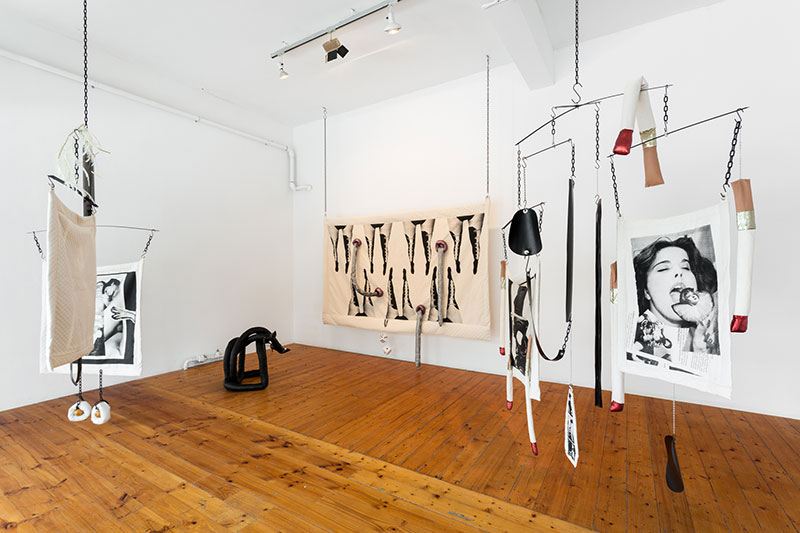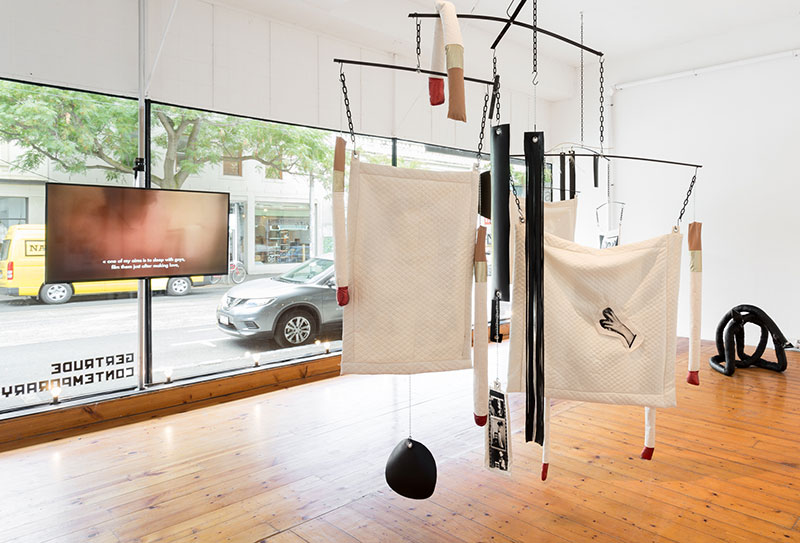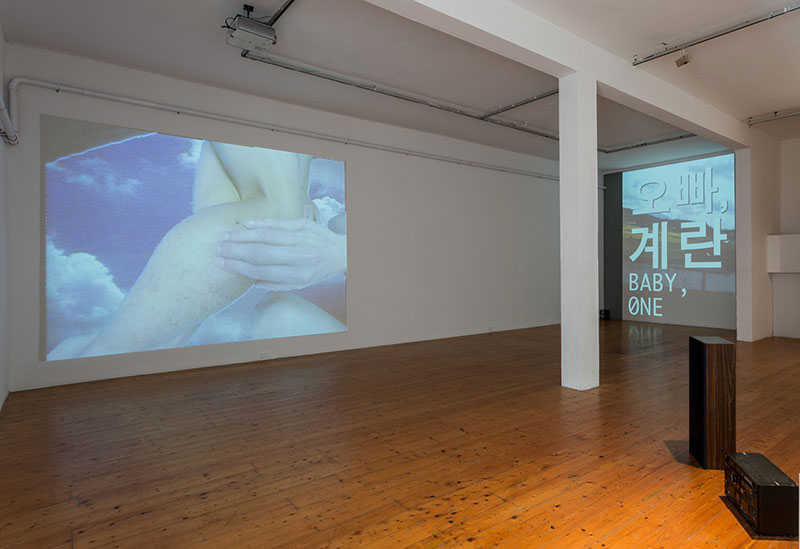
In Gertrude Contemporary’s first exhibition for 2017, This is Not a Love Song, Artistic Director Mark Feary explores notions of sex and desire and how these acts are represented within artistic practice. While acknowledging recent exhibitions that focus on ideas surrounding the nude in art, such as Nude: Art from the Tate collection and We used to talk about love exploring the emotions of love and longing, both shown recently at the Art Gallery of NSW This is Not a Love Song, as the title suggests, takes an alternative approach. Feary’s exhibition is not about emotional love or ongoing relationships, nor does it offer us sex through a pornographic lens. Rather, it seeks to honour the act of sex as a primordial desire liberated from inhibition, cultural suppression and restraint. The exhibition brings together early and recent works from a mix of Australian and International artists at various stages of their careers and features new work by Sydney-based artist Sarah Contos.
Considering the nature and mechanics of desire and pleasure in human relations is a complicated subject. This exhibition suggests that if we release the act of sex from the clutch of emotional love we can explore its idea as a practice of utopian freedom. It is within this framework that Feary describes the grouping of these six artists as an act of “reclamation of sex in a joyful, consensual and balanced way.”
Occupying the front gallery and in view of busy Gertrude Street, Sarah Contos’s newly commissioned body of work provides a theatrical entrance into the exhibition. Contos uses a wide range of materials in her work, such as leather, PVC, rubber, linen, cotton, plastic, steel and found objects, employing typically feminised modes of production such as quilting, stitching and the handmade to explore notions of sexual desire, eroticism, risk, identity and femininity.
Theatrics inform much of Contos’s work (she has a background in theatre set design). Much like a performance she constructs the characters that represent her alter ego, and what she can’t have in real life she makes up. She is interested in contradictions: the duality of eroticism and femininity, the dark and sinister alongside a playful innocence and sense of fun. Here, she softens the masculinity of bondage and fetishism, while remaining detached from emotion and romance as a way to reclaim historically supressed female desire.

Female limbs are known to incite men’s carnal desires – at times to the point of fetishism. Snakes n’ Ladders (2017) comprises a screen-printed collage of erotic imagery of female legs, and long metallic blue snake-skin appendages protruding from orifices made of fabric piping, which become phallic symbols. A quilted edge borders the central print and a pair of fluffy dice hangs from the lower edge. Here, Contos explores the fetishised female limb as phallic symbol, while at the same time representing the softness of femininity through the quilted edge.
Similar references to desire and fetishism are embodied in Carpet Burn (2017). Contos’s quilted black PVC cylindrical sculpture coils around itself forming a pair of legs in black patent leather high heels, which flop over their pedestal in post-coital fashion. Like Sarah Lucas’s sculptures which evoke tangled limbs adorned with objects of sexual identity, Contos’s assemblages reinterpret this monument of feminine pulchritude to suggest a more powerful female position. Adorned with sexual and erotic references Contos’s work represents and reclaims the historical taboo that is strong female desire.
This duality is also present in her hanging assemblages, which suggest children’s toys and the equipment of sadomasochism. These works feature sexually suggestive imagery, references to silent films, sexual freedom and risk (hand cuffs, leather straps) as well as a softer, playful lightness of touch (using feathers and stage props such as plastic fruit). An example of this is the enlarged fabric cigarette, which drapes lifelessly over the steel hanging mobile, like an exhausted limb in Emotional Sway (2017). The cigarette is a theatrical gesture of female empowerment, sexual freedom and gender parity.
Positioned to face Contos’s work and reflecting her gestures, French artist Justine Pluvinage’s film takes on female desire, emancipation, risk, intimacy, and love. Forming part of her documentary Fucking in Love, the 6-minute video Jo (2012), is the story of a one-night stand. After the breakup of her long-term relationship the artist sets out on a search for love. Here, the artist’s camera is intrusive and subjective as she films herself having sex with a guy named Jo, who she met in a nightclub hours earlier. The artist films her intimate encounter in the bathroom of Jo’s apartment through a foggy lens, created by steam from a shower, which is left running to drown out the noise of the couple in the next room. This acts as a filter, giving the film a diffused light, which blurs the bodies and adds a sense of romance to the otherwise risky rendezvous. Feary suggests that Pluvinage’s work re-internalises the experience of that powerful female position and feminised libido that Contos alludes to.

The erotic charge continues into Gertrude’s main gallery space in the work of pioneering Swiss artist Pipilotti Rist. Pickelporno (1992) is a 12-minute video, which responds to the debate about feminism and pornography that raged in the early 1990s. Rist uses sumptuous imagery, including mountains, water, fire, skin, hair, flowers, foliage, coral and overripe fruit: bodies float in space and spin with the universe, skin and fruit morph into one another, the camera accelerates then slows down as it pans across the earth ending in an explosive, cosmic climax.
On the opposite wall, US artist William E. Jones’s 16-mm film Tearoom (2007) explores sexual freedom, social control and repression. The film is comprised entirely of police surveillance footage from a public restroom, initially used to prosecute violators of anti-sodomy laws. Prior to 1962, sodomy was a felony in every state in the United States, punished by a lengthy term of imprisonment. In the film, men enter and exit the restroom to use the urinal. This progresses to masturbation, hand jobs, blow jobs and sex. The silence of Tearoom and its raw, unedited, grainy footage echoes the secrecy and humiliation endured, the perfunctory nature of this act of fulfilment undertaken at great personal risk.

Melbourne-based artist Catherine Ryan’s sound installation Why, Why Can’t This Moment Last Forever More? (2016) is comprised of two speakers, an amplifier and an open turntable, which are placed in a straight line extended diagonally into the gallery space to create an auditory inter-relationship between the works. The sound recording is an extraction of Swedish pop idol Loreen’s song Euphoria. The lyrics played repeatedly defer to a moment of ecstasy while being melancholic in their iteration. Why, Why Can’t This Moment Last Forever More? resonates throughout the gallery space, creating a sense of connectivity between the works in the show.
Projected onto the full height of the back wall, Seoul-based web art duo Young-hae Chang Heavy Industries employ text-based animation synchronised to a musical score and superimposed over static or moving images in their work. Me, My Baby, and Bibimbop (2013) is a work about the mixed rice dish that is Korea’s representative traditional food and unfolds in a series of quick-fired text messages of a sexual encounter between a couple, injecting humour and an element of the absurd into the exhibition.
This is Not a Love Song is not about love, rather it suggests an idealistic vision of sexual practice, devoid of customary protocol, repression, taboo and traditional cultural conventions. The exhibition attempts to reclaim desire and celebrate the act of sex in a pleasurable, consensual and honest way, while reflecting on the multiplicity of experiences and perspectives.













